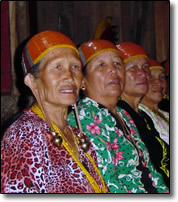
Kelabit Dancing
That night, two Australian travellers we had met in Miri organized a traditional dance party with some of the local women. Gathered in a large room by the general store was a collection of older Kelabit ladies in traditional dress. The women wore headcaps of multicolored beads and vibrant, long dresses. Their earlobes hung below their shoulders, held stretched with decorative brass weights. The dancing started. Wooden bars were placed parallel on the ground about two meters apart. On either side, assistants held two long, wooden poles on the bars, then stomped and clacked them together in a steady rhythm. Stomp stomp stomp clack! The aim was to dance between the two poles, alternating feet, and to avoid getting an ankle caught when the two poles came together. It looked deceptively easy. The pole stompers liked to increase the rhythm quickly. After a demonstration from a few of the women and children, it was our turn. A sideliner held our hands to prevent tripping and falling. We did all right, although it was hard to judge the right moment to jump between the poles. There was plenty of laughter and comment as everybody tried the dance.
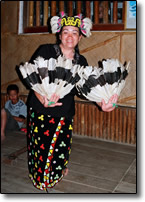 |
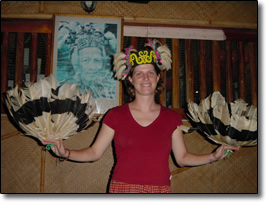 |
Then an elderly man came over, kneeled down, and, bending between the two poles, proceeded to dance with his head! Nobody could top that. The poles were removed, and a feather dance was performed. A woman dressed in traditional costume performed an elegant dance with tufts of hornbill feathers in each hand. An 11-year-old girl put on another splendid rendition. To general laughter and applause, Anne, with the feathered hat and tufts, danced her own version. Next came a war dance from the distinguished, head-dancing man. He strutted around with a machete at his side before drawing the blade and slicing it through the air. I took the machete and feathered hat, and attempted my own version of the war dance.
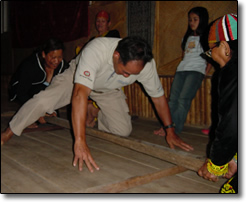 |
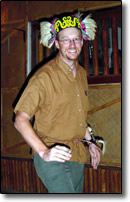 |
Everybody rose, formed a circle and danced in single file around the room, kids weaving and frolicking among participants. Pretty soon Anne and Vera were dressed in traditional costume, with beaded headcaps and faux extended earlobes improvised from old panty hose. The older ladies showed us their tattooed calves, almost solid black with zigzag patterns. One told how, 12 years old, she had run away from the longhouse to avoid the painful process, performed then with a bamboo needle and “ink” made from charcoal and ashes. Today, the tradition has died out, and only the older women have tattoos.
 |
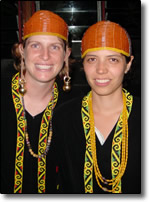 |
